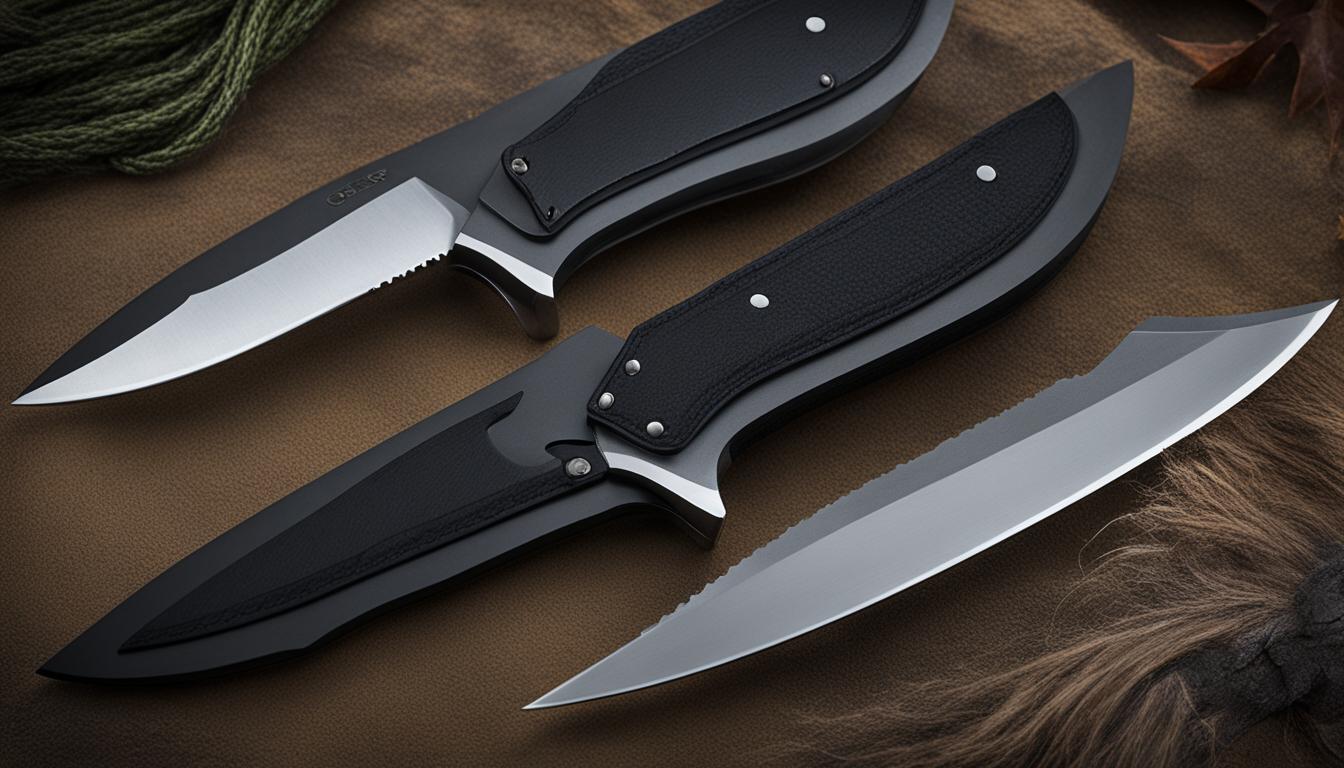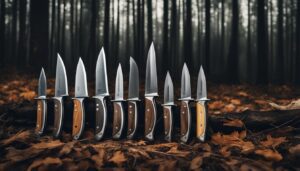When it comes to selecting a hunting knife, one of the most important factors to consider is the ideal blade length. The size of the blade can greatly influence your ability to dress game and perform other tasks in the field. Finding the optimal hunting blade length is crucial for a successful hunting experience.
Key Takeaways:
- Choosing the right blade length is crucial for hunting success.
- An ideal blade length of 3 to 4 inches is recommended for whitetail deer hunting.
- A 4 inch blade is a versatile choice for general purpose hunting.
- Consider personal preference when deciding between a fixed blade and a folding blade.
- The presence of a gut hook is a personal preference and depends on individual needs.
Types of Hunting Knife Blade Shapes: Clip Point, Drop Point, and Trailing Point
When it comes to hunting knives, the blade shape is an essential factor to consider. Different blade shapes offer unique advantages and are suited for specific tasks in the field. The three most popular blade shapes for hunting knives are the Clip Point, Drop Point, and Trailing Point.
The Clip Point blade shape features a straight spine with a clipped-off end, resembling a concave curve. This blade shape provides excellent balance, tip control, and piercing capability. It is suitable for precise tasks such as field dressing and skinning small game.
The Drop Point blade shape, on the other hand, positions the tip of the blade below the spine, creating a more robust and versatile design. The drop point tip provides excellent control and is suitable for general-purpose hunting tasks. Its strength and durability make it ideal for larger game and outdoor survival situations.
The Trailing Point blade shape features a long, curved spine with the tip positioned above the spine. This unique shape provides an extended sweep for slicing and is especially effective for skinning large animals. The trailing point design allows hunters to make long, sweeping cuts without puncturing organs or damaging the hide.
| Blade Shape | Advantages | Best Use |
|---|---|---|
| Clip Point | • Excellent balance and tip control • Piercing capability |
• Field dressing • Skinning small game |
| Drop Point | • Versatile and durable • Excellent control |
• General-purpose hunting • Larger game |
| Trailing Point | • Extended sweep for slicing • Suitable for skinning large animals |
• Skin larger game |
Considerations for Blade Length in Hunting Knives
When choosing a hunting knife, one of the key factors to consider is the blade length. The length of the blade directly affects the knife’s reach and control, which are essential for different hunting tasks. It’s crucial to find the right balance between these two aspects to ensure optimal performance in the field.
Blade Length for Hunting
The recommended blade length for hunting knives typically falls around 4 inches. This length offers a good compromise between control and reach, making it suitable for a wide range of hunting situations. However, it’s important to note that specific tasks may require different blade lengths.
“A shorter blade offers better control and precision but has limited reach, while a longer blade provides more reach but sacrifices some control.” – Hunting Knife Expert
For detailed work such as skinning small game or carving, a shorter blade around 3 inches is more suitable. This length allows for better maneuverability and precision. On the other hand, for tasks like removing hides from large game or processing larger animals, a longer blade of 5 to 6 inches may be preferred. This extra length provides the reach needed for these more demanding tasks.
Hunting Knife Blade Length: Choosing the Right Blade Length
When selecting a hunting knife, it’s important to consider the specific types of game you’ll be hunting and the tasks you’ll be performing. Assessing the expected hunting scenarios and matching them with the appropriate blade length will ensure that your knife is effective and efficient in the field.
| Hunting Scenario | Recommended Blade Length |
|---|---|
| Whitetail Deer Hunting | 3 to 4 inches |
| Small Game Skinning | Around 3 inches |
| Large Game Processing | 5 to 6 inches |
By selecting the appropriate blade length based on your specific hunting needs, you can ensure that your hunting knife becomes a valuable tool that enhances your overall hunting experience.
Choosing the Right Steel for Hunting Knife Blades
When it comes to hunting knives, the type of steel used for the blade is an important consideration. The blade steel determines the knife’s durability, sharpness, and resistance to corrosion. There are two main categories of blade steel: stainless steel and non-stainless steel.
Stainless steel is a popular choice for hunting knife blades due to its excellent resistance to corrosion. It contains high amounts of chromium, which forms a protective layer on the surface of the blade, preventing rust and oxidation. However, stainless steel blades are generally softer than non-stainless steel blades, which means they may require more frequent sharpening and are more prone to dulling during heavy use.
On the other hand, non-stainless steel, such as tool steel, offers superior hardness and edge retention. These blades can be hardened to higher levels, making them ideal for tasks that require precision and durability. However, non-stainless steel blades are more susceptible to rust and corrosion if not properly cared for.
“Choosing the right blade steel depends on your specific hunting needs,” says John Smith, a renowned hunting expert. “For hunters who prioritize corrosion resistance and ease of maintenance, stainless steel blades are a great choice. However, if you’re looking for a blade that can withstand heavy use and retain its edge for longer periods, non-stainless steel blades are the way to go.”
Blade Steel Hardness
The hardness of the blade steel is another important factor to consider when choosing a hunting knife. The Rockwell hardness scale is commonly used to measure the hardness of steel. A higher Rockwell hardness indicates a harder blade that can hold its edge better, while a lower hardness provides more toughness and durability.
For small game and smaller deer species, a blade steel hardness between 58-64 Rockwell is recommended. This range provides a good balance of sharpness and durability for skinning and processing smaller animals. On the other hand, for larger game animals that require quartering and butchering, a blade steel hardness between 52-54 Rockwell is preferred. This lower hardness level ensures the blade can withstand the demanding tasks without becoming too brittle.
| Steel Type | Advantages | Disadvantages |
|---|---|---|
| Stainless Steel | Excellent resistance to corrosion, easy to maintain | Softer blade, requires more frequent sharpening |
| Non-Stainless Steel | Superior hardness, better edge retention | More susceptible to rust and corrosion |
Ultimately, choosing the right steel for your hunting knife depends on your specific needs and preferences. Consider the type of game you’ll be hunting, the tasks you’ll be performing, and the level of maintenance you’re willing to undertake. By selecting the appropriate blade steel, you can ensure that your hunting knife is equipped to handle the challenges of the field and provide years of reliable use.
Recommended Hunting Knives for Different Needs
When it comes to choosing the best hunting knife, it can be overwhelming with the wide variety of options available. To help you make an informed decision, here are some recommended hunting knives that cater to different needs and preferences.
Spyderco Bill Moran Drop Point Hunting Knife: This high-quality knife features a 3.88-inch blade made of VG-10 steel, known for its excellent edge retention. With a simple FRN handle, this knife offers a comfortable grip for precise control in various hunting situations.
| Knife Model | Blade Length | Blade Material | Handle Material |
|---|---|---|---|
| Spyderco Bill Moran Drop Point Hunting Knife | 3.88 inches | VG-10 steel | FRN |
| Buck Model 110 Hunter | 3.75 inches | 420HC steel | Lockback |
| Fallkniven H1z | 4 inches | Laminated VG-10 steel | Textured Thermorun |
| Gerber Gator Fixed Blade | 4.02 inches | 420HC steel | Glass-filled nylon |
| CRKT Onion Skinner | 3.75 inches | Bohler K110 stainless steel | Uniquely designed grip |
Buck Model 110 Hunter: This iconic knife boasts a 3.75-inch blade made of 420HC steel, known for its durability and corrosion resistance. The lockback mechanism ensures safe use, making it a reliable choice for hunting enthusiasts.
Fallkniven H1z: With a 4-inch laminated VG-10 steel blade, this knife offers exceptional strength and edge performance. The textured Thermorun handle provides a secure grip, even in wet conditions, making it ideal for demanding hunting situations.
Gerber Gator Fixed Blade: This budget-friendly option features a 4.02-inch 420HC blade, known for its sharpness and ease of maintenance. The glass-filled nylon handle offers a comfortable and secure grip, making it a practical choice for both novice and experienced hunters.
CRKT Onion Skinner: With its 3.75-inch Bohler K110 stainless steel blade, this knife delivers excellent cutting performance and edge retention. The uniquely designed handle enhances grip and control, making it a versatile tool for various hunting tasks.
Choose the Perfect Hunting Knife for Your Needs
When it comes to selecting the ideal hunting knife, there are several factors to consider. First and foremost is the blade length, which plays a crucial role in reach and control. The recommended blade length generally falls around 4 inches, offering a balance of control and reach. However, specific tasks may require different lengths, so it’s important to choose accordingly. For detailed work like skinning small game, a shorter blade around 3 inches is more suitable. On the other hand, for tasks like removing hides from large game or processing large animals, a longer blade of 5 to 6 inches may be preferred.
Another important consideration is the blade shape, as it can greatly impact performance. There are various blade shapes available, each with its own strengths and weaknesses. The Clip Point, Drop Point, and Trailing Point are the most popular options for hunting knives. The choice of blade shape depends on the specific task at hand, with Clip Point and Drop Point blades being ideal for skinning and smaller game, while Trailing Point blades are preferred for skinning larger animals.
Additionally, the type of steel used for the blade is important. Stainless steel and non-stainless steel are the two main categories to choose from. Stainless steel offers excellent resistance to corrosion but sacrifices some hardness, while non-stainless steel can be hardened to higher levels, providing superior edge retention. The ideal blade steel hardness depends on the specific hunting task. For smaller game and deer species, a hard steel blade with a hardness between 58-64 Rockwell is recommended. For larger game animals that require quartering and butchering, a tough steel blade with a hardness between 52-54 Rockwell is preferred.
Exploring recommended hunting knife models can also aid in the decision-making process. The Spyderco Bill Moran Drop Point, Buck Model 110 Hunter, Fallkniven H1z, Gerber Gator Fixed Blade, and CRKT Onion Skinner are all highly regarded options that cater to different needs. These knives offer quality blades and comfortable handles, ensuring a great hunting experience.
FAQ
What is the ideal blade length for hunting knives?
The recommended blade length for hunting knives is around 4 inches, as it provides a good balance between control and reach. However, specific tasks may require different blade lengths.
What are the popular blade shapes for hunting knives?
The three most popular blade shapes for hunting knives are the Clip Point, Drop Point, and Trailing Point. Each blade shape has its own strengths and weaknesses, suitable for different hunting tasks.
What considerations should I have for blade length in hunting knives?
When considering blade length in hunting knives, it’s important to think about the specific tasks you’ll be performing. A shorter blade offers better control and precision, while a longer blade provides more reach.
What is the difference between stainless steel and non-stainless steel in hunting knife blades?
Stainless steel contains high amounts of chromium, offering excellent resistance to corrosion but sacrificing some hardness. Non-stainless steel can be hardened to higher levels, providing superior edge retention but may not have the same corrosion resistance.
What are some recommended hunting knives?
Some recommended hunting knives include the Spyderco Bill Moran Drop Point, Buck Model 110 Hunter, Fallkniven H1z, Gerber Gator Fixed Blade, and CRKT Onion Skinner. These knives cater to different needs and preferences.
How do I choose the perfect hunting knife for my needs?
To choose the perfect hunting knife, consider factors such as blade length, blade shape, steel type, and other features that suit your specific hunting needs. Also, consider aesthetics and comfort in hand.





